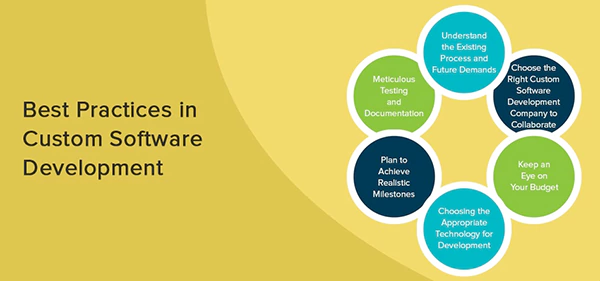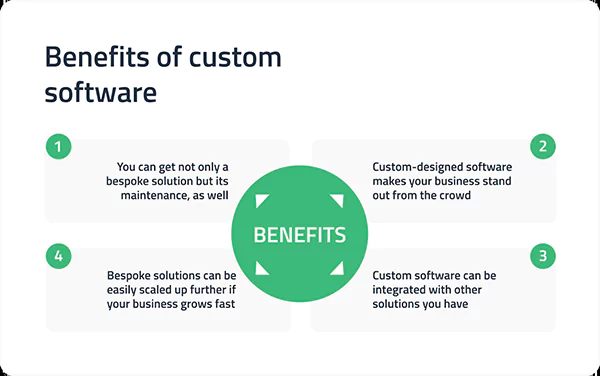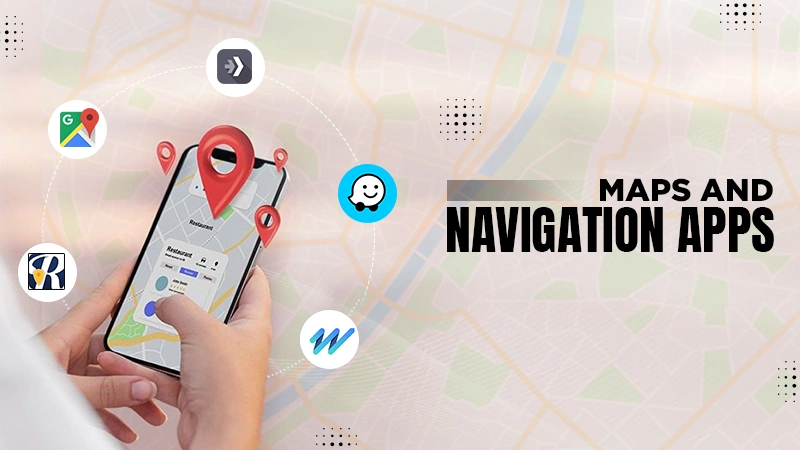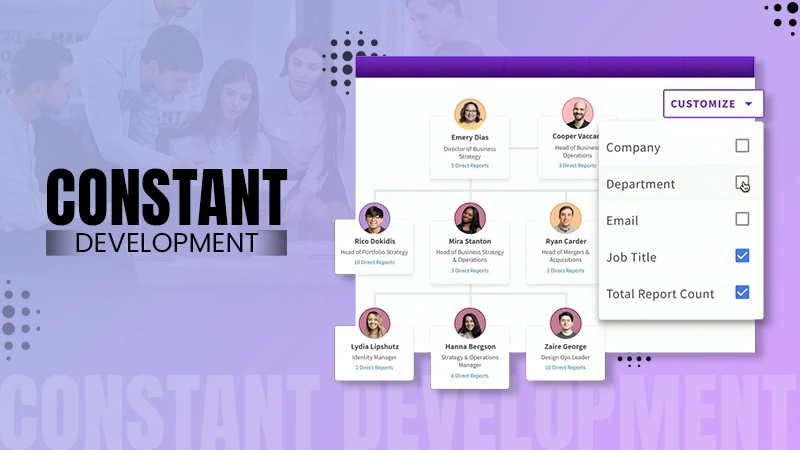Top 5 Practices for Successful Custom Software Development
Jump To Key Section
- Clearly Define Your Current and Future Requirements.
- Select Suitable Personnel for the Project.
- Develop a Feasible Plan with Defined Milestones.
- Implement Thorough Testing.
- Maintain Detailed Documentation.
- The Process of Developing Software
- Requirement Analysis and Planning
- Visual and Technical Design
- Development & Implementation
- Testing
- Deployment and Maintenance

Behind every app on your phone and the browser you use on your laptop, there are lines of code that make everything possible. custom program is developed to meet the specific needs of the target audience. Also, learn about Custom Software Development for Startups & Practices for Successful Custom Software Development with this guide.
A successful custom program brings value to the customer, attracts investment, and increases the company’s revenue. As a leading provider, Software Development Agency Lincoln, NE, delivers top-tier software solutions to customers across the region. it stands out as a vital step for businesses seeking tailored solutions. In this read, we will explore some indispensable practices for successful custom application development along with the comprehensive process of developing software.
Clearly Define Your Current and Future Requirements.
To effectively build software, it’s fundamental to delineate your existing processes, expectations, and criteria for success.
Pay attention to:
- Existing Processes: Engage with subject-matter experts who deal with these processes regularly, including both internal employees and external experts or vendors. Aim to gather comprehensive details.
- Problem Identification: Challenge assumptions that new is automatically better. Validate your hypothesis or seek feedback from stakeholders at all levels.
- Vision of Success: Illustrate the ideal workflows and other functionalities you expect from the software, ensuring comprehensive coverage.
Select Suitable Personnel for the Project.

Several options exist for developing custom software:
- Your in-house IT team, including your Chief Technology Officer (CTO).
- Individuals hired or contracted specifically for this task.
- External software development firms and vendors.
Although it might seem cost-effective to use your internal IT team, consider the potential drawbacks. They may already be committed to other tasks, and not all IT personnel have application development expertise.
A custom software development agency can often be a more practical choice, enabling collaboration with teams experienced in creating custom programs, possibly even with specialization in your industry.
Develop a Feasible Plan with Defined Milestones.
Form a team comprising your developers, subject-matter experts, and a project manager to steer the project. Develop a realistic project roadmap – complex systems can’t be built overnight.
Set milestones to maintain project momentum, marking specific stages of development to be completed within certain timeframes and budgets. Regularly assess progress at each milestone, adjusting timelines or budgets as necessary.
Implement Thorough Testing.
Conduct comprehensive analysis before rolling out the software company-wide, including both technical and user analysis.
- Technical Testing: Performed by developers and IT professionals to confirm the program’s foundational functionality.
- User Testing: Conducted by selected business users to validate the software’s performance and usability, ensuring a seamless user experience and interface.
Maintain Detailed Documentation.

Document every phase of development and implementation, including:
- An assessment plan and checklist to thoroughly evaluate the software.
- A scope statement to avoid overextending the program’s capabilities.
- An implementation strategy detailing user adoption timelines.
- A training program and exhaustive user manuals to prevent user frustration and confusion during the software rollout.
Did You Know?
There are 91.88 male software developers worldwide.
The Process of Developing Software

Software development is like building a house, both require careful planning, teamwork, and a step-by-step approach. As the process involves significant cost, there are a few indispensable steps that can’t be skipped, and play a vital role in determining the success of your freeware. Here are 5 key steps that can’t be skipped when developing an application.
Requirement Analysis and Planning
Here, client objectives are transformed into a workable plan for both parties.
Before proceeding, both sides need to document and confirm client requirements. These are captured in a Software Requirement Specification (SRS) document, guiding the product’s design and development. This planning also helps avoid any misunderstandings.
Visual and Technical Design
Understanding what needs to be built, the next step is determining how to build it. Each application solution demands a unique approach, making system architecture design pivotal. The SRS document outlines the internal design of program modules, considering factors like design modularity and risk assessment.
This phase’s outputs include wireframes, technical architecture, database design, high-fidelity screens, prototypes, user stories, and database schema.
Development & Implementation
This stage, often the lengthiest, involves the actual building of the product. Developers begin coding based on the SRS document and the visual and technical designs. Successful completion of prior stages facilitates smoother coding.
Development approaches vary depending on the application development model. Many companies now use Agile methodology, incorporating iterative Scrum meetings for team progress and issue reporting.
Testing
After software development services, assessment is paramount to identify and rectify defects. Testers perform various functional and non-functional tests. Key aspects tested include:
- Core application functionality.
- Local machine installation.
- Device compatibility.
- Text input.
Detected bugs are fixed and retested until the freeware meets quality standards. Both development and client teams should be involved in testing.
Software testing techniques include:
- Functional Testing: Involves checking each program function against expected results, using tools like Selenium, soapUI, Watir, and JUnit. Types include unit, smoke, end-to-end, integration, acceptance, regression, whitebox, interface, and black box analysis.
- Non-Functional Testing: Focuses on application aspects like reliability, usability, security, and performance, enhancing software quality significantly. Types include performance, load, failover, usability, efficiency, localization, security, reliability, and endurance assessment.
Deployment and Maintenance
After thorough testing, the freeware is released. Post-release, unexpected issues might arise, requiring immediate or future fixes.
Deployment choices include on-premise (software on company servers, offering full control over external integrations) and cloud-based (using virtual computing resources on platforms like AWS, Azure, or Google Cloud for scalability and flexibility).
Maintenance is a significant advantage of custom software, with development companies handling upgrades and additional functionalities post-release.








